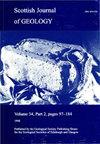苏格兰西北高地非常大的汇合多槽冰川沉积
IF 0.5
4区 地球科学
Q4 GEOLOGY
引用次数: 1
摘要
我们描述了苏格兰西北高地的两个大型汇聚多槽冰川矿床,并指出它们与格陵兰岛和南极洲目前正在冰川消融的地区出现的许多地貌相似。我们认为,它们都是由当地冰流沉积的本地沉积物引起的,而当地冰流在横向上受到更大的邻近冰川或冰流边缘的限制。因此,西北高地的特征似乎可能是德文西冰川作用后期活动过程的结果。其中一个矿床位于布鲁姆湖和小布鲁姆湖之间的半岛上,显然来源于Beinn Ghobhlach的面向西部的Coire Dearg,但它是沿WNW方向而不是沿WSW下降线布设的。这表明,安放它的冰被当时占据布鲁姆湖和小布鲁姆湖附近山谷的大型冰川边缘所限制。第二个更大、更突出的矿床位于阿普克罗斯,由抱石托里阶砂岩组成,直到被冰川冲刷的基岩侵位;这种材料唯一可行的来源位置是大约12 公里外,这要求沉积物由冰携带穿过Strath Maol Chalum槽,并在活跃的冰流将其横向限制在今天的位置时就位。反过来,这就要求阿普克罗斯和斯凯之间的内湾结冰,达到400–500的高度 比现在的海平面高出m。韦斯特罗斯队以15-14的比分再次晋级 ka在最东边的笛子上留下了一块侧冰碛碎片,并用丘状冰碛掩埋了笛子的末端。我们假设槽纹沉积物反映了冰流边缘的位置,而不是冰流本身的流线,冰流边缘限制了局部来源的冰输送沉积物的沉积。本文章由计算机程序翻译,如有差异,请以英文原文为准。
Very large convergent multi-fluted glacigenic deposits in the NW Highlands, Scotland
We describe two large convergent multi-fluted glacigenic deposits in the NW Highlands, Scotland, and point out their resemblance to a number of landforms emerging from presently deglaciating areas of Greenland and Antarctica. We suggest that they all result from locally sourced sediment being deposited by local ice-flow, which was laterally confined by the margins of much larger adjacent glaciers or ice-streams. The NW Highlands features thus seem likely to be the result of processes active during the latter part of the Devensian Glaciation. One of these deposits, on the peninsula between Loch Broom and Little Loch Broom, is evidently sourced from the west-facing Coire Dearg of Beinn Ghobhlach, but was emplaced in a WNW direction rather than along the WSW fall-line. This suggests that the ice that emplaced it was confined by the margins of large glaciers then occupying the adjacent valleys of Loch Broom and Little Loch Broom. The second much larger and more prominent deposit, in Applecross, is composed of bouldery Torridonian sandstone till emplaced on to glacially scoured bedrock; the only feasible source location for this material is about 12 km distant, which requires that the deposit was carried by ice across the trough of Strath Maol Chalum and emplaced while active ice-streams confined it laterally to its present-day location. This, in turn, requires that ice lay in the Inner Sound between Applecross and Skye to an elevation 400–500 m above present-day sea-level. The Wester Ross Re-advance of 15–14 ka left a fragment of lateral moraine against the most easterly flute and buried the distal end of the flutes with hummocky moraine. We hypothesize that the fluted deposits reflect the locations of the ice-stream margins that constrained deposition of locally derived ice-transported sediment, rather than the flow-lines of the ice-stream itself.
求助全文
通过发布文献求助,成功后即可免费获取论文全文。
去求助
来源期刊

Scottish Journal of Geology
地学-地质学
CiteScore
1.70
自引率
0.00%
发文量
10
审稿时长
>12 weeks
期刊介绍:
Although published only since 1965, the Scottish Journal of Geology has a long pedigree. It is the joint publication of the Geological Society of Glasgow and the Edinburgh Geological Society, which prior to 1965 published separate Transactions: from 1860 in the case of Glasgow and 1863 for Edinburgh.
Traditionally, the Journal has acted as the focus for papers on all aspects of Scottish geology and its contiguous areas, including the surrounding seas. The publication policy has always been outward looking, with the Editors encouraging review papers and papers on broader aspects of the Earth sciences that cannot be discussed solely in terms of Scottish geology.
The diverse geology of Scotland continues to provide an important natural laboratory for the study of earth sciences; many seminal studies in geology have been carried out on Scottish rocks, and over the years the results of much of this work had been published in the Journal and its predecessors.
The Journal fully deserves its high reputation worldwide and intends to maintain its status in the front rank of publications in the Earth sciences.
 求助内容:
求助内容: 应助结果提醒方式:
应助结果提醒方式:


